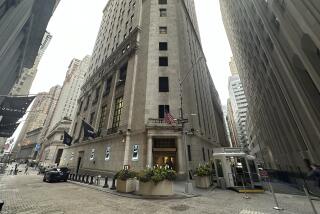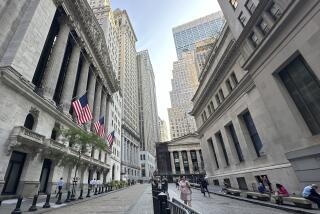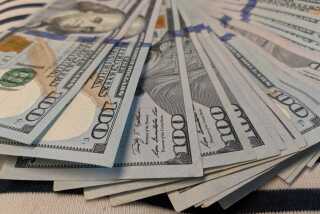Dollar Rockets on Growing Optimism for U.S. Economy
- Share via
The dollar rocketed in value Friday, soaring to a seven-month high against the German mark amid growing confidence about the U.S. economy and new worries about stability in Eastern Europe.
“The turnabout in psychology has been a bit more dramatic than many people may have expected,” said Gary Schlossberg, an economist at Wells Fargo Bank in San Francisco. “By most measures, the dollar was seriously undervalued when it hit its low point” earlier this year.
The dollar surpassed the psychological barrier of 1.6000 German marks, trading at 1.6070 marks late Friday in New York, up from 1.5825 on Thursday. It hasn’t reached such heights since last summer. The dollar was quoted at 137.85 Japanese yen late Friday, compared to 135.87 a day earlier.
The greenback’s rally came despite waves of selling by central banks, reportedly including the U.S. Federal Reserve, Germany’s Bundesbank and the Bank of Canada, in a failed bid to slow the U.S. currency’s rise. The Fed was unloading dollars for marks and yen, traders said.
There is “tremendous momentum” behind the dollar rally, Alfonso Alejo, assistant vice president at Mitsui Taiyo Kobe Bank in New York, told the Dow Jones News Service.
“The apparent need for dollars by corporate buyers is so great that modest central bank intervention is simply ineffective,” he added.
The dollar’s momentum arises in part from an emerging faith that the U.S. recession will wind down in the coming months, traders said. If that view proves correct, it would mean that U.S. interest rates are not likely to fall sharply--good news for holders of U.S. securities.
The dollar may also be benefiting from travails elsewhere in the world. Political unrest in the Soviet Union, Yugoslavia and Albania has taken luster from the German mark and made the dollar relatively more attractive, according to analysts.
A slowdown in Japan’s economy, meanwhile, has increased the likelihood of a cut in Japanese interest rates, also bolstering the U.S. currency.
Because of all these forces, “the central banks’ return to the market was less than triumphant,” said Kevin Lawrie, a director of foreign exchange for the Bank of Boston. “Nothing happened.”
Major shifts in the value of key currencies often provoke central bank intervention in the marketplace because such shifts have important implications for international trade. A weaker dollar, for example, brings cost advantages to U.S. producers relative to foreign rivals. A stronger dollar has the opposite effect, hindering America’s long-term trade prospects.
For all the enthusiasm among currency traders, however, the U.S. economic outlook still appears cloudy, analysts say.
Output at the nation’s factories, mines and utilities fell sharply in February for the fifth straight month, the worst string of setbacks since the last recession eight years ago, the government reported Friday. News that producer prices, excluding food and energy, eased for the third month in a row was viewed as a more ambiguous sign.
“If in fact the economy begins to weaken at a good pace, we could see a flip-flop in the dollar,” Schlossberg said.
More to Read
Inside the business of entertainment
The Wide Shot brings you news, analysis and insights on everything from streaming wars to production — and what it all means for the future.
You may occasionally receive promotional content from the Los Angeles Times.










